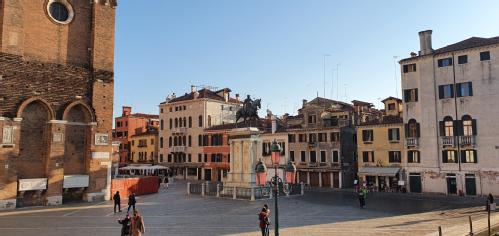The Campo Exercise
The Campo Exercise is designed to get you out into the city, starting to observe and get to know one of the greatest historical documents we have: Venice itself. As well as thinking like historians, you need to draw on the skills of the anthropologist, the sociologist, the architectural and art historian... In addition to getting to know a part of the city, it will introduce you to various themes of the module and a key aspect of Venetian culture, past and present: public space.
1. Once you are assigned your Campo you need to find it and spend at least an hour there, sometime during the first week.
2. Use the list of keywords and questions below as a starting point. Walk around and look, then sit down and observe, taking notes on your impressions. If possible, go back more than once, at different times of day, and see how it changes. Look for unusual details, things you might not notice if you were just passing through quickly. You could take photographs which you could include in your Exercise.
3. Look at at least 2-3 of the readings below as inspiration for how to do urban history and think about particular urban spaces.
4. Afterwards, distill your notes into a 1500-word essay focusing on ONE of the keywords below in relation to your observation of the Campo - whatever you found most interesting and thought-provoking. You essentially need to show how, as a historian, you can use your observation of the Campo as evidence to illuminate an aspect of Venice's past.
5. This is an assessment that needs to be submitted via Tabula. It needs proper footnotes and references following the MHRA style guide.
Keywords:
Smells | Sounds | Commercial activity | Consumption | Religion | Nature | Information | Power | Government | Communication | Ages/Generations | Gender | Wealth | Origins | Ethnicity | Family | History | Memory | Writing | Passing through | Street/Campo Names | Plaques | Statues | Public services | Belonging | Exclusion | Interaction | Languages | Water | Stone | Transport | Surveillance | Public | Private | Protest | Sociability | Observation | Ritual | Community | Leisure | Work | Crime | Mobility | Migration | Hospitality
Questions:
- What are the most important pieces of architecture on the Campo?
- Which of these might have been there in the Renaissance?
- Which ones do you think are still used for the same purpose?
- What kinds of activities take place in the Campo?
- What kinds of people use the Campo?
- How is information communicated in the Campo and what kind? (Look at signs, posters, plaques, graffitti...)
- What kinds of sounds to do you hear? Smells?
- How does the Campo change at particular times of day or days of the week?
- Does it change across the hour you spend there?
Campi
- Campo Santo Stefano
- Campo Santa Maria Formosa
- Campo San Giacomo dell'Orio
- Campo Santa Margherita
- Campo del Ghetto
- Campo Santi Giovanni e Paolo
- Campo San Giovanni in Bragora
- Campo San Polo
- Campo dei Frari
- Campo San Luca
- Campo San Barnaba
- Campo San Bartolo (San Bartolomio)
Suggested Readings:
- Atkinson, Niall, The Noisy Renaissance: Sound, Architecture, and Florentine Urban Life (University Park, 2016). E-book.
- Calabi, Donatella. The Market and the City: Square, Street and Architecture in Early Modern Europe, translated by Marlene Klein (Aldershot, 2004). E-book.
- Clarke, Giorgia, and Fabrizio Nevola, 'Introduction: The Experience of the Street in Early Modern Italy', I Tatti Studies in the Renaissance 16.1 (2013), 47-55.
- de Vivo, Filippo, 'Walking in Sixteenth-Century Venice: Mobilizing the Early Modern CityLink opens in a new windowLink opens in a new window', I Tatti Studies in the Italian Renaissance 19.1 (2016), 115-41
- Elet, Yvonne. ‘Seats of Power: The Outdoor Benches of Early Modern Florence’, Journal of the Society of Architectural Historians, 61.4 (2002), 444–69.
- Fenlon, Iain, Piazza San Marco (Cambridge, Mass., 2012). E-book.
-
Milner, Stephen J., 'The Florentine Piazza della Signoria as Practiced Place', in Roger J. Crum and John T. Paoletti, eds., Renaissance Florence: A Social History (Cambridge, 2006), 83-103.
-
Muir, Edward, 'The Virgin on the Street Corner: The Place of the Sacred in Italian CitiesLink opens in a new windowLink opens in a new window', in Steven Ozment, ed., Religion and Culture in the Renaissance and Reformation (Kirksville, MO, 1989), 25-40.
-
Nevola, Fabrizio, 'Surveillance and Control of the Street in Renaissance Italy', I Tatti Studies in the Renaissance 16.1 (2013), 85-106.
-
Nevola, Fabrizio, 'Review Essay: Street Life in Early Modern Europe', Renaissance Quarterly 66.4 (2013), 1332-1345.
-
Rau, Susanne, History, space, and place, trans. by Michael Thomas Taylor (Abingdon and New York, 2019), E-book
-
Romano, Dennis, 'Gender and the Urban Geography of Renaissance Venice', Journal of Social History 23.2 (1989): 339 - 53.
-
Salzberg, Rosa, 'The Margins in the Centre: Working Around Rialto in Sixteenth-Century Venice', in The Place of the Social Margins, 1350-1750, edited by Andrew Spicer and Jane L. Stevens Crawshaw (New York, 2016), 135-52.
-
Tassini, Giuseppe, Curiosità veneziane, ovvero origini delle denominazioni stradali di Venezia. Rev. ed. by Lino Moretti (Venice, 1970). Available on archive.org.
- ... And for an inspiring take on how the remains of Renaissance buildings continue to exert their presence in Italian public spaces, watch the wonderful short video about the virtual reconstruction of the destroyed church of San Pier Maggiore in Florence ...

